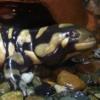 |
The Western Tiger
Salamander (Ambystoma mavortium)
was designated the official state AMPHIBIAN
on March 16, 2012, thanks to the efforts of
9th-grader Larissa Babiak. |
Wings Over the Rockies
was designated the official AIR &
SPACE MUSEUM of Colorado in 1997. [official
website] |
|
 |
The Rocky Mountain
Bighorn Sheep (Ovis canadensis)
was adopted as the official state ANIMAL
on May 1, 1961. |
The Lark Bunting
(Calamospiza melanocoryus stejneger) was
adopted as the official state BIRD
on April 29, 1931. |
 |
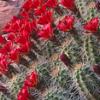 |
Thanks to the efforts of
Douglas County Girl Scout Troop 2518, in Castle
Rock, the Claret Cup Cactus (Echinocereus
triglochidiatus) was designated the official
state CACTUS on March 7, 2014. |
The Greenback
Cutthroat Trout (Oncorhynchus clarki
somias) was adopted as the official state FISH
on March 15, 1994. Once indigenous to many small
creeks, streams and rivers throughout most of
Colorado, this species was almost exterminated by
pollution from mine tailings and is now only
found in small populations in a few remote
streams in Rocky Mountain National Park. |
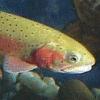 |
 |
The state FLAG
was adopted by an act of the General Assembly on
June 5, 1911. It consists of three alternate
stripes of equal width -- the two outer being
blue of the same color as in the field of the
national flag and the middle being white -- and a
circular red C of the same color as the red
stripes of the national flag enclosing a golden
disk. The flag was originally designed by Andrew
Carlisle Carson, but the precise colors were not
designated until February 28, 1929; the size of
the C, as well as its distance from the staff,
was fixed by the General Assembly on March 31,
1964. |
The White and Lavender
Columbine (Aquilegia caerules)
was adopted as the official state FLOWER
on April 4, 1899, following a vote amongst the
school children of Colorado. |
 |
| |
The Square Dance
was adopted as the official state FOLK
DANCE on March 16, 1992. |
The Stegosaurus was
designated as the official state FOSSIL
on April 28, 1982. The first Stegosaurus fossil
was found in Colorado in 1876. There are only six
skeletons of the Stegosaurus on public display in
the United States, one of which may be viewed at
the Museum of Natural History in Denver. |
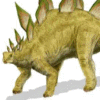 |
 |
The Aquamarine
was adopted as the official state GEMSTONE
on April 30, 1971. The peaks of Mount Antero and
White Mountain are among the finest localities
known for gem-quality aquamarine. |
Blue Grama
was adopted as the official state GRASS
on May 20, 1987. A state grass was designated to
help inform and educate citizens and tourists
about the economic and conservation significance
of grasslands. |
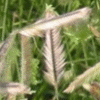 |
 |
The Colorado
Hairstreak Butterfly (Hypaurotis
cyalus) was adopted as the official state INSECT
on April 17, 1996, thanks to the efforts of 4th
graders from Wheeling Elementary in Aurora (led
by teacher Melinda Terry). |
Rhodochrosite
was designated the official state MINERAL
on April 17, 2002. This deep red to rose pink
mineral is associated internationally with the
state more than any other mineral because the
world's largest Rhodochrosite crystal, called the
Alma King, was found in the Sweet Home Mine near
Alma, and is now on display at the Denver Museum
of Nature and Science. |
 |
| |
The state MOTTO,
Nil Sine Numine, is Latin for
"Nothing without the Deity." It was
adopted as part of the Territorial Seal in 1861. |
Colorado designated Shelter
and Rescue Dogs and Cats as the official
state PETS in 2013. |
|
 |
In 2007, Jay Baichi's 4th
grade class began the process to get the Western
Painted Turtle (Chrysemys picta
bellii) designated as the official state REPTILE.
The next year's class completed the process, and
the legislation was signed on March 18, 2008. |
In 2004, Girl Scout Troop 357
of Lakewood petitioned the Legislature to have Yule
Marble designated as the official state ROCK,
and it was so designated on March 9, 2004. A
marble deposit was first reported in 1882 in
Gunnison County on Yule Creek. The outstanding
quality of Yule Marble made it the choice for use
in the Colorado State Capitol, as well as the Washington Monument, the Lincoln Memorial, the Tomb of the Unknown Soldier, and
other national monuments. |
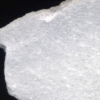 |
 |
The design of the Official SEAL
of the State of Colorado was adapted from that of
the Territorial Seal, which was adopted by the
First Territorial Assembly on November 6, 1861.
The present design was approved by the first
General Assembly on March 15, 1877. At the top is
the Eye of God within a triangle, from which
golden rays radiate on two sides. Below the eye
is a scroll, the Roman Fasces (the insignia of a
republican form of government), a bundle of birch
or elm rods (symbolizing strength which is
lacking in a single rod) with a battle axe
(symbolizing authority and leadership) bound
together by red thongs and bearing on a band of
red, white and blue, the words "Union and
Constitution." Below the scroll is a
heraldic shield bearing across the top on a red
ground three snow-capped mountains with clouds
above them. The lower half of the shield has two
miner's tools, the pick and sledge hammer,
crossed on a golden ground. Below the shield in a
semicircle is the state motto. |
Where the
Columbines Grow -- words and music
by A.J. Fynn -- was adopted as the official state
SONG on May 8, 1915. Traveling
by horse and wagon to visit Indian tribes in the
San Luis Valley in 1896, Fynn received
inspiration to write the song after he came
across a beautiful Colorado mountain meadow which
was covered with columbines and dedicated it the
Colorado pioneers. [click here for the words and an
audio clip] Rocky Mountain High
-- words by John Denver, music by Mike Taylor --
was adopted as another state song on March 12,
2007. The song was released in 1973 by John
Denver, who was born Henry John Deutschendorf,
Jr., but took his stage name from the capital
city of Colorado. |
|
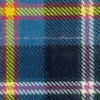 |
The official state TARTAN
is comprised of a pattern and colors that
symbolize Colorado's splendor and history. The
pattern (sett) consists of primary blocks of
forest green and cerulean blue, separated by
broad dividing bands of black, with the forest
green checks containing two pairs of tram tracks
consisting of lavender and white and with the
cerulean blue checks containing a gold stripe
with red guard lines. It was adopted on March 3,
1997. |
On Arbor Day in 1892, Colorado
school children voted to name the Colorado
Blue Spruce (Picea pungens) as
the official state TREE, but it
was not so designated until March 7, 1939. The
species was first discovered on Pike's Peak in
1862 by botanist C.C. Parry, and named by George
Engelmann in 1879. |
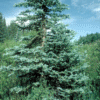 |

















